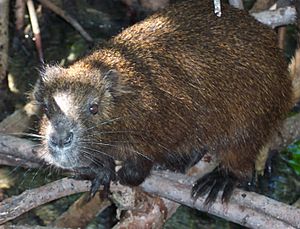Desmarest's hutia facts for kids
Quick facts for kids Desmarest's hutia |
|
|---|---|
 |
|
| Conservation status | |
| Scientific classification | |
| Genus: |
Capromys
|
| Species: |
pilorides
|
| Subspecies | |
|
|
The Desmarest's hutia or Cuban hutia (Capromys pilorides) is a furry, rat-like mammal. It is found only on the island of Cuba and some nearby islands. This animal can grow to about 60 centimeters (2 feet) long. It usually lives in pairs and eats leaves, fruit, bark, and sometimes small animals.
The Desmarest's hutia is the largest living hutia. Hutias are a group of rodents that live in the Caribbean. Many other types of hutias are now endangered or have become extinct. Luckily, the Desmarest's hutia is still common in Cuba. However, one type of Desmarest's hutia, called C. p. lewisi, used to live in the Cayman Islands. It died out a long time ago, soon after Europeans arrived in the 1500s.
Contents
What Does a Desmarest's Hutia Look Like?
A Desmarest's hutia's body can be from 31 to 60 centimeters (12 to 24 inches) long. Its tail adds another 14 to 29 centimeters (5.5 to 11.5 inches) to its length. These animals can weigh between 2.8 and 8.5 kilograms (6 to 19 pounds).
They have thick, rough fur that covers their whole body, even their tail. Their fur can be black, brown, light sand-colored, or even red. Desmarest's hutias have a strong, stocky body and short legs. They usually walk with a slow, wobbly movement. But if they need to escape, they can hop quickly! Their feet have five toes with big claws, which help them climb trees easily.
Where Do Desmarest's Hutias Live?
Desmarest's hutias live in many different kinds of places. In northern Cuba, you might find them living near mangrove trees. In southern Cuba, they prefer to live more on land. They are very common in the Guantánamo Province, especially around the Guantanamo Bay Naval Base. However, in the mountains of eastern Cuba, their numbers are getting smaller.
These hutias are only found in Cuba, but they live all over the main island. You can also find them on Isla de la Juventud, the Sabana archipelago, the Doce Laqunas archipelago, and many other small islands and cays around Cuba.
As mentioned, a type of Desmarest's hutia called C. p. lewisi used to live in the Cayman Islands. It became extinct after Europeans arrived. Some people think that the famous explorer Francis Drake might have seen these hutias when he visited the islands. He wrote about "little beast-like cats" and "coneys" (which are like rabbits) living there.
How Do Desmarest's Hutias Behave?
Desmarest's hutias usually live in pairs, but you might also see them alone or in small groups. They are active during the day, which means they are diurnal. They do not dig burrows. Instead, they rest at night in hollow spots in rocks or trees.
These animals are omnivores, meaning they eat both plants and animals. However, they mostly eat bark, leaves, and fruit. Sometimes, they will also eat small vertebrates, like lizards. Both male and female hutias mark their territory using their urine. This helps them tell other animals that the area is theirs.
Reproduction and Young Hutias
Desmarest's hutias can have babies all year round. A mother hutia is pregnant for about 110 to 140 days, usually around 120 to 126 days. The busiest time for them to have babies is in June or July.
They typically have one to three young at a time. A newborn hutia weighs about 230 grams (8 oz). The babies are born very developed. They have fur, their eyes are fully open, and they can walk right away! They drink their mother's milk for about five months. They become old enough to have their own babies when they are about ten months old. In zoos, Desmarest's hutias can live for eight to eleven years.
Desmarest's Hutias and Humans
For a long time, people in Cuba hunted hutias for food. Their meat was considered tasty, and their size meant they could provide a good meal. In 1968, a law called the Wild Animals Protection Act was passed. This law made it illegal to hunt or kill hutias without special permission from the government.
In some places, there are so many hutias that they can cause damage to crops. When this happens, people might see them as a pest.
Naming the Desmarest's Hutia
The scientific name for the Desmarest's hutia is Capromys pilorides. The name Capromys comes from two old Greek words. "Kapros" means "pig" or "boar," and "mys" means "mouse" or "rat."
The Desmarest's hutia was first described in 1788 by a scientist named Peter Simon Pallas. He called it Mys pilorides. Later, scientists realized it didn't belong in that group. So, in 1935, George Henry Hamilton Tate placed it in the group Capromys.
The common name, Desmarest's hutia, is named after Anselme Gaëtan Desmarest. He was a scientist who described the species in 1822.
There are five types of Desmarest's hutias that are still alive today. They are called ciprianoi, doceleguas, gundlachianus, pilorides, and relictus. Scientists have studied their genes. They found that the ciprianoi and relictus types, both from Isla de la Juventud, are very similar. However, the gundlachianus type, found on Cayo Fragaso, is a bit different genetically.
The extinct type, C. p. lewisi, from the Cayman Islands, is known from many old bones found in the ground. It was similar to the Cuban Capromys pilorides but smaller. The oldest bones found are from the last Ice Age, and the newest are from around the year 1600.
Images for kids
See also
 In Spanish: Jutía cubana para niños
In Spanish: Jutía cubana para niños




